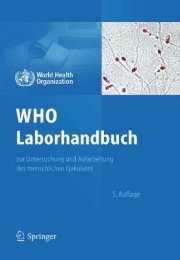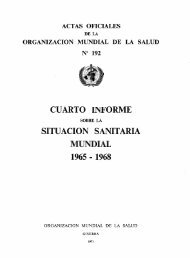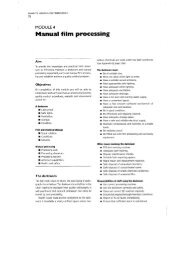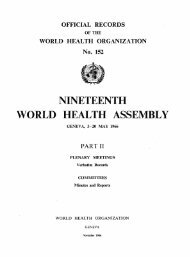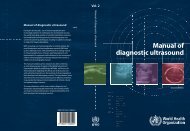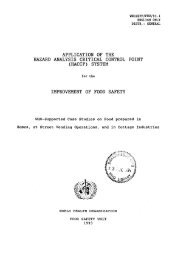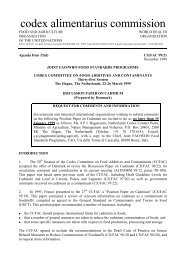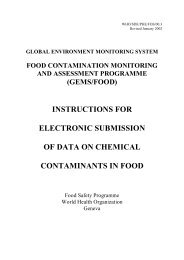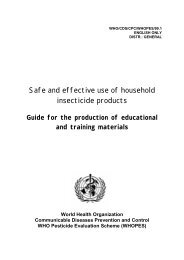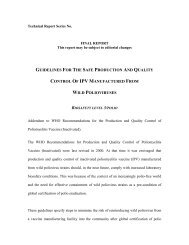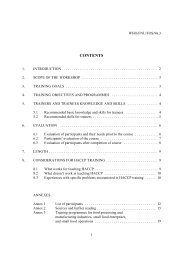WHO Drug Information Vol. 20, No. 4, 2006 - World Health ...
WHO Drug Information Vol. 20, No. 4, 2006 - World Health ...
WHO Drug Information Vol. 20, No. 4, 2006 - World Health ...
Create successful ePaper yourself
Turn your PDF publications into a flip-book with our unique Google optimized e-Paper software.
Medicines for Tuberculosis<br />
pounds currently in the pipeline are either<br />
derivatives of existing compounds or they<br />
target the same cellular processes as<br />
drugs currently in use. Whilst analogues<br />
and derivatives are far quicker to develop,<br />
they may be subject to cross-resistance,<br />
as has been the case with the new<br />
rifamycins and quinolones.<br />
Modern technologies and rational approaches<br />
to drug design such as creation<br />
of genomic libraries of M. tuberculosis<br />
conditional knock-out mutants for<br />
comprehensive target identification and<br />
validation, target-based drug discovery, or<br />
determination of three dimensional crystal<br />
structure of molecular targets, are still<br />
weakly implemented.<br />
Even the more promising candidate<br />
compounds currently in clinical development<br />
were identified serendipitously.<br />
There is also an urgent need for rational<br />
approaches aimed at tackling the problem<br />
of mycobacterial persistence. The<br />
adaptations that allow M. tuberculosis to<br />
persist in the host despite a vigorous<br />
adaptive immune response likely contribute<br />
to the difficulty in curing TB with<br />
current chemotherapy.<br />
If faster progress is to be achieved, then<br />
knowledge about M. tuberculosis metabolism<br />
and physiology needs to be translated<br />
into validated targets that can be<br />
used for screening of new lead compounds.<br />
The TB Alliance is associated<br />
with approximately half of all compounds<br />
or projects aimed to identify candidate<br />
compounds currently being developed. In<br />
order to analyse the pipeline, it is useful<br />
to group drug candidates currently in two<br />
main categories:<br />
• <strong>No</strong>vel chemical entities.<br />
• Compounds originating from existing<br />
families of drugs, where innovative<br />
chemistry is used to optimise the<br />
compounds.<br />
242<br />
<strong>WHO</strong> <strong>Drug</strong> <strong>Information</strong> <strong>Vol</strong> <strong>20</strong>, <strong>No</strong>. 4, <strong>20</strong>06<br />
<strong>No</strong>vel chemical entities<br />
Diarylquinoline TMC<strong>20</strong>7<br />
(Johnson & Johnson)<br />
Diarylquinoline TMC<strong>20</strong>7 is a promising<br />
member of a new class of anti-mycobacterial<br />
agents. The target and mechanism<br />
of action is different from those of other<br />
anti-TB agents implying low probability of<br />
cross-resistance with existing TB drugs.<br />
This is further suggested by the fact that<br />
diarylquinoline TMC<strong>20</strong>7 is able to inhibit<br />
bacterial growth when tested on MDR-TB<br />
isolates.<br />
This compound has potent early bactericidal<br />
activity in the nonestablished infection<br />
murine mouse model, matching or<br />
exceeding that of isoniazid. Substitution<br />
of rifampicin, isoniazid or pyrazinamide<br />
with diarylquinoline TMC<strong>20</strong>7, accelerated<br />
activity leading to complete culture<br />
conversion after 2 months of treatment in<br />
some combinations. In particular, diarylquinoline<br />
/isoniazid/pyrazinamide and<br />
diaryl-quinoline/rifampicin/pyrazinamide<br />
combinations cleared the lungs of TB in<br />
mice after 2 months. Diarylquinoline<br />
TMC<strong>20</strong>7 is currently in phase IIa clinical<br />
trials.<br />
Nitroimidazole PA-824<br />
(Chiron Corp.-TB Alliance)<br />
Nitroimidazole PA-824 is a new nitroimidazole<br />
derivative currently being<br />
developed by the TB Alliance. After<br />
activation by a mechanism dependent on<br />
M. tuberculosis F4<strong>20</strong> factor, PA-824 acts<br />
mainly by inhibiting the synthesis of cell<br />
wall components through molecular<br />
targets that are yet to be identified. In<br />
vitro, PA-824 showed high activity against<br />
drug-sensitive and drug-resistant M.<br />
tuberculosis strains, indicating that there<br />
is no cross-resistance with current TB<br />
drugs. Moreover, PA-824 exhibited<br />
bactericidal activity against both replicating<br />
and static bacteria in vitro. Although<br />
PA-824 was significantly more efficient



